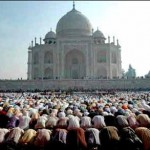 It is confirmed that the Prophet (sallallahu alaihi wa sallam) sometimes forgot something in the salah (prayer). It is also true that he said: “I am a human being and forget like you forget. If I forget, remind me.”
It is confirmed that the Prophet (sallallahu alaihi wa sallam) sometimes forgot something in the salah (prayer). It is also true that he said: “I am a human being and forget like you forget. If I forget, remind me.”
In instances like these, he (SAWS) performed what are known as the prostrations of forgetfulness (Sujud us-Sahu). There are specific points concerning such prostrations and they are presented below.
How to Perform These Prostrations
Sujud us-Sahu is two prostrations which a person makes before or after the tasleem (conclusion of prayer). All of this has been confirmed from the Prophet (SAWS). In the Sahih, it is recorded from Abu Sa’id al-Khudri that the Prophet said: “If one of you has some doubts during his salah and he does not recall (the number of rak’at) he has prayed, three or four, then he can put an end to his doubt by performing salah according to what he was certain of [the lesser amount] and then making two sujud before the tasleem.”
In the story of Dhul-Yadain, in al-Bukhari and Muslim, we are told the Prophet (SAWS) made the prostrations after the tasleem.
Ash-Shaukani says: “The best that is stated on this subject is that one must follow what the Prophet said or did, respecting the sujud before or after the tasleem. If one does something that necessitates sujud before the tasleem, one should make them before the tasleem, and if one does something requiring sujud after the tasleem, then one should make them after the tasleem.”
When to Perform These Prostrations
Sujud us-Sahu is to be performed in the following circumstances:
1. If a person makes the tasleem before he actually completes the prayers: Ibn Sireen relates from Abu Hurairah who said: “The Prophet (SAWS) prayed either Dhuhr or ‘Asr salah with us and he prayed only two rak’at and made the tasleem. He got up and leaned against a piece of wood in the mosque as if he was angry. He put his right hand on his left and interlocked his fingers. Then, he placed his cheek on the back of his left hand. Some people left the mosque in a hurry and said: ‘The prayer has been shortened?’ Among the people were Abu Bakr and ‘Umar and they were shy to speak to him. One of the people, who was called Dhul-Yadain, said: ‘O Messenger of Allah! have you forgotten or has the prayer been shortened?’ He answered: ‘I have not forgotten and it has not been shortened.’ Then he asked: ‘Is it as Dhul-Yadain has said?’ The people answered in the affirmative… At that, he led the people in what he had omitted and made the tasleem. After which he made the takbeer and prostrated the way he usually prostrated or perhaps even longer. Next, he raised his head and made the takbeer. Then, he made the takbeer [again] and prostrated, like one of his customary sujud or perhaps even longer, and finally, he raised his head.”
‘Ata’ relates that Ibn az-Zubair prayed maghrib and made the tasleem after two rak’at and then he stood up and wanted to kiss the black stone, when the people tried to correct him he said: “What is the matter with you?” Then he prayed what he had left out and performed two sujud. When this was mentioned to Ibn ‘Abbas, he said that it was not far from the Sunnah of the Prophet (SAWS). (Ahmad, al-Bazzar, and at-Tabarani)
2. In the case of an addition to the prayer: Ibn Mas’ud narrates that the Prophet prayed five rak’at and the people asked him: ‘Has there been an addition to the prayer?’ He asked: ‘Why do you say that?’ They replied: ‘You prayed five rak’at.’ Then he made two sujud after he had made the tasleem. This hadith proves that the prayer of one who prays five rak’at out of forgetfulness, without sitting during the fourth rak’ah, is acceptable.
3. In the case of forgetting the first tashahud (sitting) or one of the other sunnah acts of the prayer: Ibn Buhainah narrates that the Prophet (SAWS) stood after two rak’at. The people tried to correct him but he continued. When he finished his salah, he made two sujud and made the tasleem. This hadith shows that one who forgets the first sitting but is reminded of it and he recalls it before he completely stands should return and sit, but if he is already completely standing, he should not sit down.
4. In the case of doubt over whether or not one performed some act of the prayer: ‘Abdurrahman ibn ‘Auf reported that he heard the Prophet say: “If one of you has some doubt during his salah and he does not know if he prayed one rak’ah or two, he should take it to have been just one. If he does not know if he prayed two rak’at or three, he should take it to have been just two. If he does not know if he prayed three rak’at or four, he should take it to have been just three, (In all such cases) at the end of his prayer, while sitting, he should make two sujud before the tasleem.” (Ahmad, Ibn Majah, and at-Tirmidhi) Imanway.com
